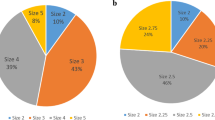Abstract
The objective of this study was to review our experience with pessary use for advanced pelvic organ prolapse. Charts of patients treated for Stage III and IV prolapse were reviewed. Comparisons were made between patients who tried or refused pessary use. A successful trial of pessary was defined by continued use; a failed trial was defined by a patient’s discontinued use. Thirty-two patients tried a pessary; 45 refused. Patients who refused a pessary were younger, had lesser degree of prolapse, and more often had urinary incontinence. Most patients (62.5%) continued pessary use and avoided surgery. Unsuccessful trial of pessary resorting to surgery included four patients (33%) with unwillingness to maintain, three patients (25%) with inability to retain and two patients (17%) with vaginal erosion and/or discharge. Our findings suggest that pessary use is an acceptable first-line option for treatment of advanced pelvic organ prolapse.
Similar content being viewed by others
References
Cundiff GW, Weidner AC, Visco AG, Bump RC, Addison WA (2000) A survey of pessary use by members of the American urogynecologic society. Obstet Gynecol 95(6 Pt 1):931–935
Pott-Grinstein E, Newcomer JR (2001) Gynecologists’ patterns of prescribing pessaries. J Reprod Med 46(3):205–208
Wu V, Farrell SA, Baskett TF, Flowerdew G (1997) A simplified protocol for pessary management. Obstet Gynecol 90(6):990–994
Sulak PJ, Kuehl TJ, Shull BL (1993) Vaginal pessaries and their use in pelvic relaxation. J Reprod Med 38(12):919–923
Bash KL (2000) Review of vaginal pessaries. Obstet Gynecol Surv 55(7):455–460
Myers DL, LaSala CA, Murphy JA (1998) Double pessary use in grade 4 uterine and vaginal prolapse. Obstet Gynecol 91(6):1019–1020
Singh K, Reid WM (2001) Non-surgical treatment of uterovaginal prolapse using double vaginal rings. BJOG 108(1):112–113
Walters MD, Iannetta LT (1997) Combination of pessary and periurethral collagen injections for nonsurgical treatment of uterovaginal prolapse and genuine stress urinary incontinence. Obstet Gynecol 90(4 Pt 2):691–692
Scotti RJ, Flora R, Greston WM, Budnick L, Hutchinson-Colas J (2000) Characterizing and reporting pelvic floor defects: the revised New York classification system. Int Urogynecol J 11:48–60
Bump RC, Mattiasson A, Bo K, Brubaker LP, DeLancey JO, Klarskov P, Shull BL, Smith AR (1996) The standardization of terminology of female pelvic organ prolapse and pelvic floor dysfunction. Am J Obstet Gynecol 175(1):10–17
Crystle CD, Charme LS, Copeland WE (1971) Q-tip test in stress urinary incontinence. Obstet Gynecol 38:313
Zeitlin MP, Lebherz TB (1992) Pessaries in the geriatric patient. J Am Geriatr Soc 40(6):635–639
Poma PA (2000) Nonsurgical management of genital prolapse. A review and recommendations for clinical practice. J Reprod Med 45(10):789–797
Author information
Authors and Affiliations
Corresponding author
Rights and permissions
About this article
Cite this article
Powers, K., Lazarou, G., Wang, A. et al. Pessary use in advanced pelvic organ prolapse. Int Urogynecol J 17, 160–164 (2006). https://doi.org/10.1007/s00192-005-1311-8
Received:
Accepted:
Published:
Issue Date:
DOI: https://doi.org/10.1007/s00192-005-1311-8




